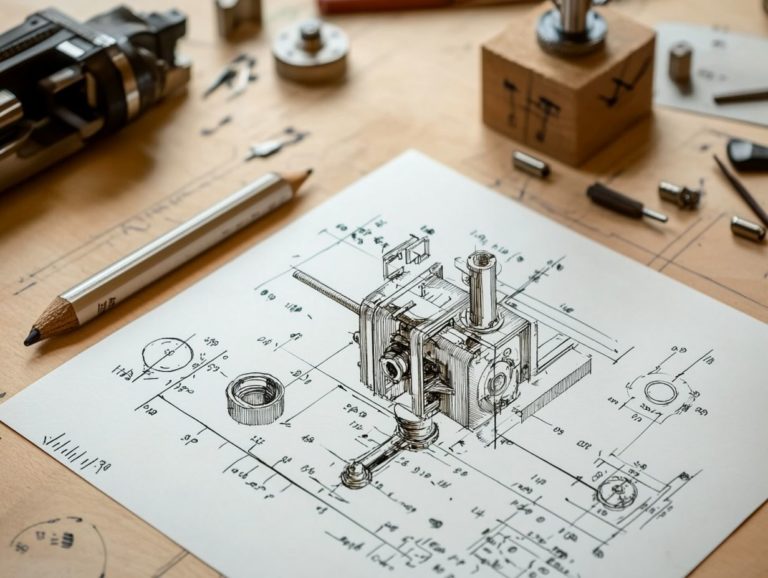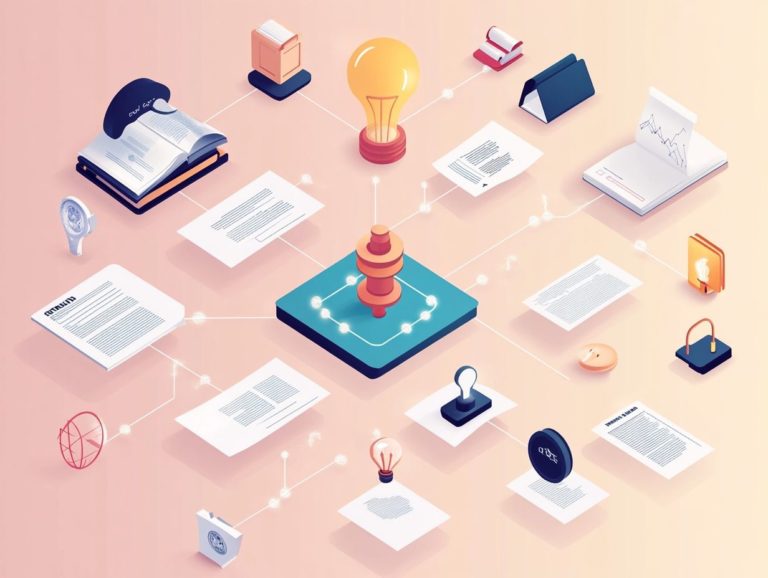5 Tips for Collaborating on Patent Applications
Navigating the complexities of patent applications can feel overwhelming, particularly when collaboration is essential. This article provides you with vital tips to streamline teamwork, from establishing clear communication channels to defining roles and responsibilities.
You ll discover how setting realistic deadlines and leveraging collaboration tools will skyrocket your efficiency and productivity! We will also delve into the benefits of collaboration, identify common challenges, and offer practical solutions.
Whether you re part of a small team or a larger organization, these insights will empower you to master the patent application process collaboratively.
Contents
- Key Takeaways:
- 1. Understand the Importance of Collaboration in Patent Applications
- 2. Establish Clear Communication Channels
- 3. Define Roles and Responsibilities
- 4. Set Realistic Deadlines and Milestones
- 5. Utilize Collaboration Tools and Software
- Why Collaborating on Patent Applications is a Game-Changer?
- How Can a Team Effectively Communicate During the Patent Application Process?
- What Are the Different Roles Involved in a Patent Application Collaboration?
- How Can Milestones Help Keep the Collaboration on Track?
- What Types of Collaboration Tools and Software Are Available for Patent Applications?
- What Are the Common Challenges of Collaborating on Patent Applications and How Can They Be Overcome?
- Frequently Asked Questions
- What is the importance of collaborating on patent applications?
- What are the key tips for successful collaboration on patent applications?
- How can open communication enhance the collaboration process for patent applications?
- Why is it important to clearly define roles and responsibilities when collaborating on patent applications?
- How can establishing a timeline benefit the collaboration process for patent applications?
- What role does technology play in successful collaboration on patent applications?
Key Takeaways:

- Collaboration is crucial in patent applications, as it allows for diverse perspectives and expertise to be combined.
- Establishing clear communication channels and defining roles and responsibilities can prevent misunderstandings and delays.
- Setting realistic deadlines and utilizing collaboration tools can help keep the process on track and improve efficiency.
1. Understand the Importance of Collaboration in Patent Applications
Collaboration in patent applications is crucial for you, as it unites diverse expertise and perspectives, elevating the overall quality of the patent process. To enhance your efforts, consider the 5 tips for conducting a patentability search to ensure robust protection for your innovative ideas in the realm of intellectual property.
When patent attorneys and legal experts work effectively together, they streamline the creation of a comprehensive patent portfolio a collection of patents owned by a company or individual and facilitate smooth technology transfer and adherence to legal requirements.
Beyond legal counsel, engineers, scientists, and marketing professionals each bring unique insights that enrich the application process. Engineers provide detailed technical descriptions, while scientists validate the novelty of inventions with compelling research data.
Involving marketing professionals ensures that the patent aligns with market needs, significantly enhancing its potential for commercial success.
A prime example of successful collaboration exists in the tech sector, where interdisciplinary teams have merged their knowledge across various fields to secure groundbreaking patents, driving innovation and securing a competitive edge.
2. Establish Clear Communication Channels
Establishing clear communication channels is essential to successfully navigate the patent application process. It fosters effective dialogue among all parties involved, including patent attorneys and examiners, ensuring that everyone understands the goals and requirements.
By employing techniques like active listening and providing regular updates, you can cultivate a more collaborative environment. Active listening allows you to truly comprehend others’ perspectives, which is crucial for addressing concerns and clarifying doubts.
Regular updates keep everyone informed about progress and changes, promoting transparency throughout the process.
These strategies not only build trust among team members but also facilitate quicker resolutions to any problems that may arise, leading to smoother interactions with the patent office. As a result, you minimize tensions, making the patent application process much simpler.
3. Define Roles and Responsibilities
Defining roles and responsibilities within your patent application team is essential for ensuring clarity and precision throughout the process. This clarity sets clear expectations for patent attorneys, examiners, and other collaborators involved.
Each member plays a crucial role in navigating the complexities of securing a patent. Patent attorneys focus on drafting and filing applications, ensuring the language meets legal standards while effectively highlighting the uniqueness of the invention. Meanwhile, patent examiners review submissions, scrutinizing claims for novelty and non-obviousness; their insights can significantly influence approval.
Inventors contribute critical technical details and insights that form the very foundation of the application. Clear communication is key for effective teamwork. Misunderstandings can lead to delays or even outright rejections. By understanding each role, you foster a cohesive team effort, ultimately enhancing the likelihood of a successful application.
4. Set Realistic Deadlines and Milestones

Setting realistic deadlines and milestones is crucial in the patent application process. It helps you manage your time effectively while ensuring that every necessary step is completed before the filing date.
Establishing clear benchmarks for each phase of the patent examination creates an environment of collaboration and accountability among stakeholders.
For instance, breaking the application into stages like initial research, draft preparation, and review helps everyone stay aligned and aware of their responsibilities.
This iterative approach enhances communication and fosters timely feedback, allowing you to make adjustments based on insights gathered throughout the process.
When you and your team collaborate with the patent office, you streamline the process and get results faster. Achieving milestones like preliminary searches or responding to office actions becomes more efficient, significantly reducing the overall time until patent approval.
5. Utilize Collaboration Tools and Software
Using collaboration tools and software is essential in the patent application process. These resources elevate your digital transformation efforts while enhancing document management and automating workflows.
These tools also facilitate seamless communication among all stakeholders think inventors, legal teams, and patent offices while providing a centralized platform for document sharing and revisions.
Cloud-based solutions offer real-time updates and feedback, significantly reducing the chances of miscommunication. Advanced software can track application progress, set deadlines, and provide reminders, effectively streamlining your workflow.
By integrating these technologies, you boost efficiency, ensuring that all necessary tasks are completed promptly and accurately. The right collaboration tools can be a game-changer in managing patent applications.
Why Collaborating on Patent Applications is a Game-Changer?
You gain many advantages by collaborating on patent applications, including better protection for your ideas, establishing a strong patent portfolio, and fostering innovation that can significantly influence your market position.
Assembling a diverse team with varied expertise enables a comprehensive exploration of ideas, ensuring that no crucial detail slips through the cracks. This collaborative approach can streamline the patent application process and minimize the likelihood of errors and misinterpretations that could lead to legal complications.
When your efforts are well-coordinated, you can craft stronger defenses against patent trolls entities that exploit legal loopholes to challenge patent claims. In this synergistic environment, inventors and legal teams work closely, resulting in a holistic strategy that safeguards your intellectual property and amplifies its value in a competitive landscape.
How Can a Team Effectively Communicate During the Patent Application Process?
To navigate the patent application process with finesse, implement strategic communication practices that promote collaboration, active listening, and clear information exchange among patent attorneys and other stakeholders.
Cultivating a culture of openness enables team members to share insights and concerns freely, building trust a cornerstone for constructive dialogue.
Active listening is essential; it allows you to grasp differing perspectives, leading to well-considered choices. When engaging in examiner interviews, preparation is key. Crafting clear, concise questions helps clarify uncertainties, and providing the examiner with necessary context streamlines discussions.
These strategies elevate communication and enhance the efficiency of your patent application process. Start implementing them today for better results!
What Are the Different Roles Involved in a Patent Application Collaboration?

In the realm of patent application collaboration, you will encounter a diverse array of roles, including patent attorneys, legal experts, and patent examiners. Each brings unique skills and expertise to facilitate a successful patent process.
Patent attorneys typically take the helm, orchestrating the overall strategy and skillfully crafting the application to emphasize the invention’s novelty. Legal experts provide invaluable insights into existing patents and potential legal hurdles. They guide you through the complex terrain of intellectual property law.
Patent examiners also play a crucial role. They meticulously analyze submissions to ensure they meet legal requirements and assess whether an invention can be granted a patent against prior art.
The collaboration among these parties is essential. Effective communication ensures that both technical and legal standards are upheld and streamlines the patenting process, enhancing the likelihood of approval.
How Can Milestones Help Keep the Collaboration on Track?
Milestones are essential for keeping your collaboration on track during the patent application process. They provide clear targets that facilitate effective communication and ensure that every task is completed ahead of the filing date.
By breaking down the process into manageable steps, you can engage in meaningful discussions, share valuable insights, and make collective decisions. This structured approach clarifies responsibilities and supports the iterative nature of patent examination.
As you and your team reach each milestone, you can review feedback, make necessary adjustments, and refine your strategies. This ultimately leads to a stronger patent application. This framework is a valuable tool for monitoring your progress, enabling everyone involved to stay aligned with overall objectives.
What Types of Collaboration Tools and Software Are Available for Patent Applications?
You ll find a variety of collaboration tools and software tailored for patent applications. Each is designed to elevate your digital transformation, enhance document management, and streamline communication among team members.
Project management platforms enable you to assign tasks, set deadlines, and monitor progress in real-time. This ensures everyone stays aligned with your objectives.
Cloud storage solutions enable secure sharing and version control of critical documents. This allows your team to collaborate seamlessly, even from remote locations.
Customer relationship management (CRM) systems help you track communication with clients and stakeholders. They simplify the management of correspondence, ensuring you retain essential information.
By leveraging these technologies, you boost efficiency and cultivate a collaborative environment crucial for innovative patent development.
What Are the Common Challenges of Collaborating on Patent Applications and How Can They Be Overcome?
Collaborating on patent applications presents a range of challenges. You might encounter communication barriers, misunderstandings of legal requirements, and the complexities of coordinating efforts among patent attorneys and examiners.
These hurdles arise from the diverse backgrounds and expertise of those involved, leading to varying interpretations of critical information.
To alleviate these issues, establish clear communication channels from the very beginning. Regular meetings, timely updates, and shared platforms for document management can greatly enhance your collaborative efforts.
Ensuring all stakeholders are well-informed about the legal intricacies of patenting significantly reduces misunderstandings.
By fostering an environment that prioritizes ongoing engagement, you can navigate these complexities more adeptly, paving the way for a smoother patent application process.
Frequently Asked Questions

Effective collaboration is crucial for a successful patent application process. By following 5 tips for navigating international patents, you can streamline your approach and enhance your chances of approval!
What is the importance of collaborating on patent applications?
Collaborating on patent applications combines our ideas and resources. This teamwork creates a stronger application that covers all necessary aspects.
What are the key tips for successful collaboration on patent applications?
The top five tips for collaborating on patent applications are:
- Maintain open communication.
- Clearly define roles and responsibilities.
- Establish a timeline.
- Conduct thorough research.
- Utilize technology for efficient collaboration.
How can open communication enhance the collaboration process for patent applications?
Open communication allows everyone to express their ideas, concerns, and questions freely. It ensures that all team members are aligned and working towards the same goal, resulting in a cohesive application.
Why is it important to clearly define roles and responsibilities when collaborating on patent applications?
Clearly defining roles and responsibilities helps prevent confusion and misunderstandings. This clarity ensures that each team member knows their specific tasks and can focus on their strengths.
How can establishing a timeline benefit the collaboration process for patent applications?
A timeline sets realistic expectations and aids in planning and preparation. It keeps the project on track and allows for timely adjustments if needed.
What role does technology play in successful collaboration on patent applications?
Technology greatly enhances collaboration by providing tools for efficient communication, document sharing, and project management. It allows team members to work together, no matter where they are located.





